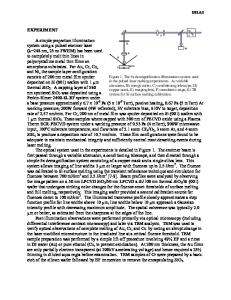Pulsed Laser Melting of Metallic Glasses
- PDF / 1,379,258 Bytes
- 6 Pages / 417.6 x 639 pts Page_size
- 83 Downloads / 318 Views
Reactor Research Centre,
ABSTRACT We have studied pulsed ruby laser melting of metallic glasses - Fe40Ni4OPl4B6 and Fe40Ni40B20. Both amorphous and crystallised samples were used, and some of them were implanted with Ru to serve as a marker species. SEM measurements on surface topography and RBS (1.8 MeV He+) depth profiling of Ru marker redistribution were used to establish melting above about 1 J/cm2 . Heat flow calculations and liquid phase diffusion analysis of the Ru marker species under a moving melt front have been performed. The observed redistribution of Ru upto 2.5 J/cm2 is consistent with an effective D - 5 x 10-5 cm2 s-1. The flat Ru depth profiles at higher energy densities are shown to arise from convection effects. Results on crystallised and amorphous samples are similar. Preliminary TEM measurements of quenched regions on a crystallised sample show an unexpected absence of amorphous phase. INTRODUCTION Pulsed laser treatment (PLT) of materials has emerged as a viable technique to form metastable surface alloys [1-4]. The rapid heating with sufficiently intense laser irradiation results in a molten surface region which resolidifies at a very fast rate due to conduction of heat to the bulk. Extremely high cooling rates (0109 Ks- 1 ) and ultrafast solid-liquid interface motion at velocities of several metres per second [5,6] are factors responsible for producing a metastable phase after laser treatment. The technique thus has an analogy with conventional splat cooling technique. Numerous studies have been reported on metastable alloy formation by PLT of semiconductors [7], as well as metals [8]. However, very few studies are available on PLT of alloys. In particular, no study has been reported on PLT of metallic glasses, though formation of a glassy phase by PLT of deposited films has been studied [9]. In this paper we present our results on pulsed laser melting of Mat. Res.
Soc.
Symp.
Proc.
Vol.
13 (1983) OElsevier Science publishing Co.,
Inc.
704 two different metallic glasses - METGLAS 2826 (Fe40Ni4OPl4B6) and METGLAS E4040 (Fe40Ni4OB20). Occurrence of melting is established by SEM analysis and redistribution of a marker species implanted in some samples. Detailed diffusion analysis of a marker profile is presented. Preliminary TEM results are reported. EXPERIMENTAL Ribbons (2 and 3 mm wide, 50 microns thick) of METGLAS 2826 and METGLAS E4040 were used in the as received condition for the present study. Irradiations were carried out in air with single pulses (% 18 ns FWHM) from a ruby laser, at energy densities upto 5.4 J/ cm2 . The spatial profile of the laser beam was homogenised using a ground diffuser plate. The diffused beam was concentrated on the target using a lens. A 3 mm diameter aperture was used almost in contact with the sample to irradiate a well defined area. Some samples were implanted with 120 key Ru+ ions to a dose of 1 x 1016 ions/cm2 to serve as a marker species for monitoring surface melting. In addition, some samples (both implanted, as well as unimplanted) were trans
Data Loading...










